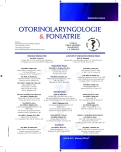Evaluation of Voice Quality by Means of DSI (Dysphonia Severity Index)
Authors:
J. Frostová 1,2; M. Lejska 1
Authors‘ workplace:
Audio-Fon-Centr, s. r. o., Brno, přednosta doc. MUDr. M. Lejska, CSc., MBA
1; Katedra hudební výchovy, Masarykova univerzita, Brno, vedoucí doc. Mgr. V. Richter
2
Published in:
Otorinolaryngol Foniatr, 63, 2014, No. 1, pp. 10-15.
Category:
Original Article
Overview
The paper describes the DSI method (Dysphonia Severity Index) as a technique for voice quality measurement. The voice parameters – quantitative, qualitative and esthetic –, are described. Moreover, the way of voice quality evaluation including subjective evaluation by the persons ourselves, subjective evaluation by a professional and objective evaluation are described, respectively. In the research part, the results of voice quality measurements in teachers are summarized. The DSI method may be recommended for use for a common practice.
Keywords:
voice quality voice assessment, Dysphonia Severity Index, teachers
Sources
1. Colton., R. H., Casper., J. K et.al.: Understanding voice problems: A physiological perspective for diagnosis and treatment. Baltimore, Lippincott Williams and Wilkins, 2006. 438 s., ISBN 0-7817-4239-0.
2. De Bodt, M. et al.: Materials and methods. In Van de Heyning, P. et al. Part II: Research work of the Belgium Study Group on Voice Disorders. Acta Oto-Rhino-Laryngologica Belg., 1996, 50, s. 325-329.
3. Frostova, J.: Changes of the quality of voice in nursery school teachers measured by the DSI and VHI methods: Evaluation on completion of a training programme In School and Health 21, Health Literacy Through Education. 1. vyd., Brno, Masarykova univerzita, 2011. s. 149-160, ISBN 978-80-210-5720-3.
4. Frostová, J.: Changes of the teachers quality of voice measured DSI in relationship to the teaching profession. In School and Health 21, 2009 Topical Issues In Health Education. 1. vyd., Brno : Masarykova univerzita, 2009. s. 135-146, ISBN 978-80-210-4930-7.
5. Frostová, J.: Changes of the vocal quality of teachers in relation to their professional preparation (as measured by the Dysphonia Severity Index). In Řehulka, Evžen (ed.). School and Health 21, Health Education: Contexts and Inspiration. 1. vyd., Brno : Masarykova Univerzita, 2010. s. 193-204. ISBN 978-80-210-5259-8.
6. Frostová, J.: Péče o hlasovou kondici učitelů. Brno, Masarykova univerzita, 2010, s. 198, ISBN 978-80-210-5355-7.
7. Gonnermann, U., Nawka, T.: Ergebnisse der Messungen des Dysphonie Schweregrad Index (DSI), Voice Handicap Index (VHI) und Heiserkeitsgrades von funktionellen Dysphonien vor und nach terapie. In Stimme – Sprechen – Sprache, Therapie, Literatur und Kunst (ed. Volkmar Clausnitzer / Erhard Miethe). 1. Aufl. Idstein: Schulz-Kirchner Verlag GmbH, 2004. s. 19-26, ISBN 3-8248-0475-1.
8. Havlík, R., Lejska, M., Bártková, E., Weberová, P., Švec, J. G., Krupa, P., Frostová, J.: Vizuální podoba pěveckého formantu. 57. slovenský otorinolaryngologický kongres a 8. česko-slovenský foniatrický kongres. Bratislava, 8. - 10. září 2010. Abstrakta s. 20, ISSN 1337-2181.
9. Havlík, R., Švec, J., Lejska, M.: Pěvecký formant. XIX. celostátní foniatrické dny Evy Sedláčkové a 6. česko-slovenský foniatrický kongres. Jablonné 25. - 27. 9.2008, s. 44-45, ISBN 978-80-7311-106-9.
10. Jacobson, B. H., Johnson,A., Grywalski,C., Sibergleicht, A., Jacobson,G., Benninger, M.: The Voice Handicap Index (VHI): Development and Validation. Am. Jour. of Speech-Language Path., 6, 1997, 3, s. 66-70.
11. Neiman, S. G., Edeson, B.: Procedual aspect of eliciting maximum phonation time. Folia Phoniatrica, 33, 1981, s. 285-293.
12. Novák, A.: Foniatrie a pedaudiologie II. Poruchy hlasu u dětí a dospělých – základy anatomie a fyziologie hlasu, diagnostika, léčba, reedukace a rehabilitace poruch hlasu. Unitisk, Praha, 2000, s. 28.
13. Novák, A.: Hodnocení kvality hlasu v klinické praxi. Česko-Slovenská otorinolaryngogie a foniatrie, 42, 1993, č.1, s. 3-10.
14. Qualification of the voice signal. University of Pittsburgh: Voice Analysis Lab, 1999. [cit.11-11-2012]. Dostupné z http://www.upmc.com/Services/ear-nose-throat/services/voice/Pages/lab.aspx.
15. Švec, J., Lejska, M., Frostová, J., Zábrodský, M., Dršata, J.,Král, P.: Česká verze dotazníku Voice Handicap Index pro kvantitativní hodnocení hlasových potíží vnímaných pacientem. Otorinolaring a Foniat. /Prague/, 58, 2009, 3, s. 132-139, ISSN 1210-7867.
16. Van de Heyning, P. et al.: Part II: Research work of the Belgium Study Group on Voice Disorders. Acta Oto-Rhino-Llaryngologica Belg., 50, 1996, s. 321-386.
17. Wuyts, F.-L., de Bodt, m., molenberghs, g. et al. The Dysphonia Severity Index: An Objektive measure of Vocal quality based on a multiparameter approach. Journal of Speech, Language and Hearing Reseach, 43, 2000, s. 796-809.
Labels
Audiology Paediatric ENT ENT (Otorhinolaryngology)Article was published in
Otorhinolaryngology and Phoniatrics

2014 Issue 1
Most read in this issue
- Bleeding of Post-Tonsillectomy
- Obstructive Sleep Apnea Syndrome - Effectivity of Different Surgical Approaches
- Atypical form of Meniere’s Disease
- The Spread of Infection through the Danger Zone in to the Mediastinum
